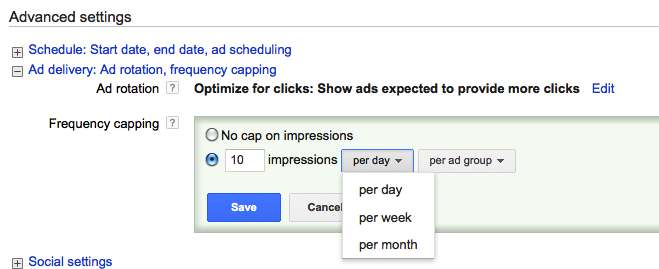-
 8 min. read
8 min. read
-
 Ryan Maake
Ryan Maake Lead Marketing Consultant
Lead Marketing Consultant
- Ryan is a Lead Marketing Consultant at WebFX. Follow him on Twitter @rmaake107! @rmaake107
Remarketing – sometimes called retargeting – is one of the most powerful digital marketing techniques available today. A proper remarketing campaign can net you incredible ROI and boost your brand visibility – but a poorly implemented one will do nothing but burn money and annoy potential customers. Keep reading for four remarketing best practices.
You’ll take a look at how remarketing works and what you can do to make sure your remarketing campaign is designed to produce the best possible results.
What is remarketing?
In the context of this post, I’ll be referring to remarketing only within the context of Google’s AdWords advertising platform. Have you ever spent some time searching for a product or service, only to find that any ads you see for the next few days are eerily relevant to whatever product or service you were looking for? That’s remarketing in action.
Following retargeting best practices can help your ads become a success, too!  To start using these ads for your business, you first need to a small Google code snippet to your website. Then, you can make remarketing lists based on specific user behaviors, along with custom remarketing list rules that you define.
To start using these ads for your business, you first need to a small Google code snippet to your website. Then, you can make remarketing lists based on specific user behaviors, along with custom remarketing list rules that you define.
For example, you could create a remarketing list made up of every user who visits a specific page, a list of users who have visited any page with a certain keyword in the URL, and so on – you can get pretty creative with your remarketing lists. After you set these lists up, you can run normal AdWords campaigns that only target users on your lists. This is why remarketing campaigns can achieve such high ROI – not only do you know that your target audience is interested in your product or service, you know that they’ve already been to your website.
Even just from a psychological standpoint, you can see how this might help. When a user sees your brand name all over the place, they’ll begin to associate it with whatever product or service they’re looking for. Remarketing is also fantastic for pushing potential customers further down your sales funnel.
Let’s say you set up a remarketing list made of users that have visited a specific informational page on your site, that falls near the very top of your sales funnel. You know these users will probably convert eventually, but if you don’t stay in contact, they may end up signing with or buying from a competitor. But with a remarketing list, you can “follow” these undecided users around for the next few days, ensuring your brand will be right in front of them when they decide to buy.
This just scratches the surface of how useful remarketing is, but you can see why it’s such a powerful tool in any marketing manager’s arsenal!
Tips for getting started with your remarketing campaign
Remarketing is an effective way to target visitors who already showed an interest in your product or services. To get the most out of your remarketing campaigns, consider the following tips:
1. Develop a remarketing strategy
Like most segments of marketing, it is important to go into a retargeting campaign with a strategy in mind — especially for advanced retargeting. Think about what lists you want to build and how you want to use these lists. Consider the goals you are hoping to achieve through the campaign and create your remarketing lists with those goals in mind.
2. Manage client expectations for goals and objectives
One of the worst feelings is seeing positive results, sharing them with your client, and then realizing they are unhappy with the data. Talking with your client about what to expect during a remarketing campaign can make the difference between them feeling pleased with the results or them wanting to shut down the campaign.
3. Make sure your privacy policy is up to date
Before you launch your remarketing campaign and add any code to the website, update your privacy policy to ensure that it declares that DoubleClick cookies are used on your site.
Best practices for your remarketing campaign
Remarketing can be extremely effective but requires careful planning to do well. Just like any advertising campaign, you’ll need to keep a close eye on your analytics and make adjustments as necessary. It might take some time, but these general remarketing best practices will help you create a valuable remarketing campaign for your company.
1. Segment audiences based on user intent
Proper segmentation is critical to the success of your remarketing efforts. The best way to do this is to take a big picture look at your site and mentally group your pages according to a few different categories – product/service pages, informational pages, resource pages, your homepage, and so on.  You then want to determine user intent with regard to these page groupings.
You then want to determine user intent with regard to these page groupings.
Continuing with the page groups above, for example, users on your product/service pages are likely closer to converting, while users on your homepage might just be checking out your company for the first time. If you set up retargeting audiences based on these page groups, you can then tailor your ads to match user intent. You might want your more aggressive, salesy ads to target your “product/service page” audience, while you could offer additional resources to your “homepage” audience instead of pushing sales on them.
Properly segmenting your audiences according to user intent is a great way to boost your effectiveness when it comes to retargeting campaigns.
2. Put a frequency cap on your retargeting campaign
This is one of the single most important steps in all of remarketing. Google lets you impose a frequency cap on your remarketing campaign so that users aren’t getting blasted by your ads 24/7.  You can choose a monthly, weekly, or daily limit, but you should almost always err on the conservative side. Internet users fully expect advertisements, but they will take note if they’re seeing ads for “Joe’s Body Shop” 5 times a day. AdWords keeps tabs on your frequency data, so if you’re not sure exactly where you should set your frequency, you can always raise or lower the cap after you have some data to dig into.
You can choose a monthly, weekly, or daily limit, but you should almost always err on the conservative side. Internet users fully expect advertisements, but they will take note if they’re seeing ads for “Joe’s Body Shop” 5 times a day. AdWords keeps tabs on your frequency data, so if you’re not sure exactly where you should set your frequency, you can always raise or lower the cap after you have some data to dig into.
3. Don’t waste money on users that have already converted
This is one that’s easy to forget about. After a user converts (via your remarketing campaign or otherwise), they’ll still be a part of whatever audience list they initially were added to until that cookie expires. This means that even after they purchase a specific product, they could still see ads for that product – which is a waste of your advertising budget.
 This is where “burn pixels” become useful. These are tracking pixels that remove users from a certain remarketing list. It’s easy to solve this issue with Google.
This is where “burn pixels” become useful. These are tracking pixels that remove users from a certain remarketing list. It’s easy to solve this issue with Google.
You can simply create a new remarketing list consisting of users that have converted. You can then upload that list as a “negative audience” within your remarketing campaign so that users who’ve already converted won’t be targeted by that specific campaign. You can even go a step further here and target those already-converted users with new ads, either upselling them, offering other resources or whatever else you might want them to see.
4. Send remarketing traffic to tailored landing pages
This tip applies to any online advertising campaign but is even more applicable when it comes to remarketing audiences.  If you’re running a normal AdWords campaign, you can create landing pages tailored to users based on the keywords each ad targets. With remarketing campaigns, you can do the same thing but based on past behavior, which is often a stronger foundation for landing page relevance.
If you’re running a normal AdWords campaign, you can create landing pages tailored to users based on the keywords each ad targets. With remarketing campaigns, you can do the same thing but based on past behavior, which is often a stronger foundation for landing page relevance.
Because you know they’ve already been on a certain section of your website, you can be even more confident that you know what they want to see in a landing page. Taking the time to set up proper landing pages for your remarketing campaigns can result in some of the highest landing page conversion rates you’ll ever see!
Keep experimenting with new types of remarketing
There are currently five ways to remarket with Google Ads:
- Standard remarketing
- Dynamic remarketing
- Remarketing lists for search ads
- Video remarketing
- Customer list remarketing
We recommend testing the different types to meet the needs of each campaign. Let your imagination and data help you try new approaches to earn your clients the best results.
See remarketing examples in action!
Need some inspiration of retargeting best practices in action for your next remarketing campaign? Check out these examples of remarketing that convert!
And contact WebFX to get started with custom remarketing services!
-
 Ryan is a Lead Marketing Consultant at WebFX. Follow him on Twitter @rmaake107!@rmaake107
Ryan is a Lead Marketing Consultant at WebFX. Follow him on Twitter @rmaake107!@rmaake107 -

WebFX is a full-service marketing agency with 1,100+ client reviews and a 4.9-star rating on Clutch! Find out how our expert team and revenue-accelerating tech can drive results for you! Learn more
Try our free Marketing Calculator
Craft a tailored online marketing strategy! Utilize our free Internet marketing calculator for a custom plan based on your location, reach, timeframe, and budget.
Plan Your Marketing Budget

Maximize Your Marketing ROI
Claim your free eBook packed with proven strategies to boost your marketing efforts.
Get the GuideTry our free Marketing Calculator
Craft a tailored online marketing strategy! Utilize our free Internet marketing calculator for a custom plan based on your location, reach, timeframe, and budget.
Plan Your Marketing Budget





